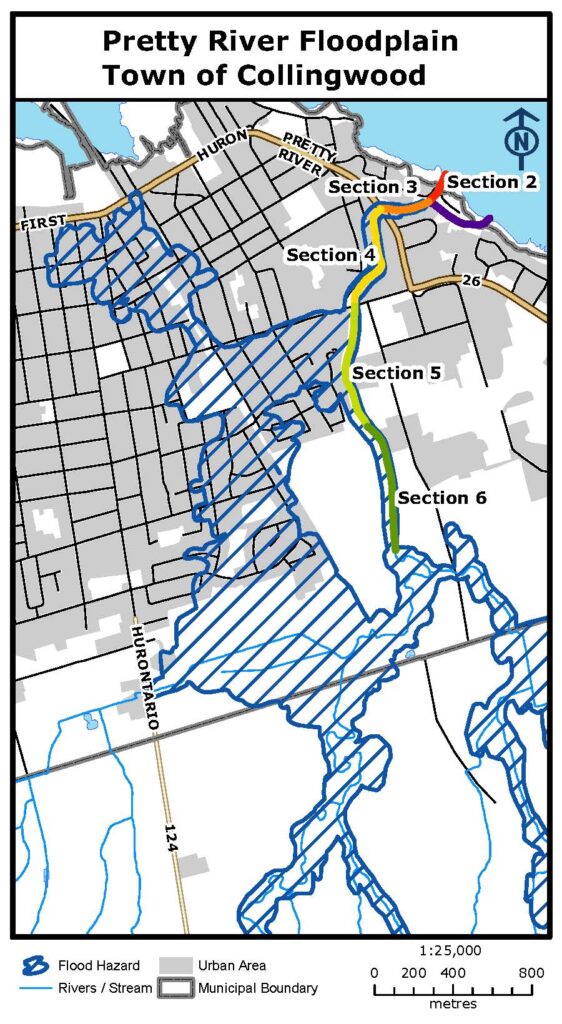Pretty River Dike Maintenance
The Pretty River Dike was designed to help keep the downtown areas of Collingwood safe from flooding.
In order to make sure it functions properly, some of the vegetation growing along the banks of the dike must be removed from time to time.
Climate Change may increase the likelihood of more intense storms over time, putting pressure on the Pretty River Dike infrastructure.
History of Flooding in Collingwood
The Town of Collingwood was built on a shallow floodplain, making it prone to floods. Some of the most notable floods are the 1912 Victoria Day Flood and the 1942 St. Patricks’ Day Flood.
The Pretty River
The Pretty River is one of four rivers that flow through the Town of Collingwood. It starts on the Niagara Escarpment, and flows through the Pretty River Valley. As it enters the town, it is contained by the Pretty River Dike as it flows to the Nottawasaga Bay.
The Pretty River Dike
In the 1970s, the Pretty River Dike was built to reduce the risk of flooding in the urban areas of Collingwood.
It is designed to contain the floodwaters from the Provincial Regulatory Storm Event — a storm so extreme that the likelihood of it happening is less than 1% chance in any given year. Although these events are rare, the risk to property damage and possible loss of life is high which is why the dike must be maintained.

This 2 km flood control structure starts at the southwest intersection of Peel Street and Lynden Street, passing the old CN Rail bridge (now the Siding Trail), then Hume Street and the Pretty River Parkway before ending at Oliver Crescent near the shore of Nottawasaga Bay.
The Pretty River Dike is divided into five sections.
- Section 2: Bypass Weir/Culverts to Nottawasaga Bay
- Section 3: Pretty River Parkway to Bypass Weir/Culverts
- Section 4: Hume Street to Pretty River Parkway
- Section 5: Barrie Collingwood Railway (Siding Trail) to Hume Street
- Section 6: Start of Pretty River Dike to Barrie Collingwood Railway (Siding Trail)
This is what the dike looked like in the 1970s right after it was built. As time went on, vegetation began to grow on the dike. Taking a closer look, the dike is covered in 12″ to 18″ stone which protects the banks from the erosive forces of flowing water.

NVCA removed vegetation on the dike in 2006 and 2007. However, a recent study found that vegetation such as trees and large shrubs has continued to grow on the dike, slowing down the flow of flood waters and reducing the capacity of the corridor which in turn could lead to flood waters spilling over the dike during the Regulatory flood event.
River Trail
The recreational trail will continue to be available to residents and visitors. Most of the vegetation beside the trail will remain with the exception of trees that could impact the stability of the dike. After the vegetation removal, trail users will have a clearer view of the river.
Portions of the trail will be closed from time to time for maintenance activities for trail users’ safety.
How will the vegetation be removed?
The vegetation will be removed in two phases for every section.
Phase One – Remove the Understory (small material)
This phase includes removing small woody material such as smaller trees and large shrubs along the slope of the dike. Lower shrubs such as dogwoods and willows along the edge of the water will not be removed. To prevent the spread of invasive species, the vegetation will be disposed at an approved site such as a county landfill or a composting facility.
Phase Two – Assessing and Removing Select Trees.
Once Phase One is completed, NVCA will inventory and assess the larger trees and shrubs and develop a plan to remove those that are compromising the flood capacity of the Pretty River Dike. More information about Phase Two will be available after Phase One is complete.
Maintenance Timelines
Maintenance work will begin on Sections 4 and 5 (see map in brochure) of the Pretty River Dike. Phase One will start in the Fall of 2021, and Phase Two is expected to start in 2022. To protect nesting migratory birds, vegetation removal will not take place between April through July.
Maintenance work will be ongoing, and residents should expect regular vegetation removal along the dike.
What will the dike look like after the vegetation is removed?
Currently, dense tree, shrub and ground cover are covering the small stone which protects the banks from the erosive forces of flowing water. After the trees and large shrubs are removed, the stone and river will be more visible, when looking from the River Trail.
Fish and Wildlife habitat
It is important to strike a balance for community safety, water quality and habitat protection. Although trees and large shrubs must be removed to ensure flood waters can flow through the dike, groundcover such as grasses and wildflowers along the dike will not be removed. These plants are important habitats for pollinators, including Monarch butterflies, a species of concern. Groundcover is also a great foraging source for many birds.
Low shrubs such as dogwood and willows along the edge of the water will not be removed to continue to support fish and wildlife habitat. Ground cover and low shrubs retained along the dike system will quickly recover from any disturbance associated with removal work. The urban natural corridor associated with the Pretty River will continue to function.
For more information, please contact
Chris Hibberd
Director, Watershed Management Services
Nottawasaga Valley Conservation Authority
8195 8th Line, Utopia, ON L0M 1T0
705-424-1479
flood@nvca.on.ca
Engineering Services Department
Town of Collingwood
P.O. Box 157
97 Hurontario Street
Collingwood, Ontario L9Y 3Z5
705-445-1292 ext. 4200
engineering@collingwood.ca
 Planning & Permits
Planning & Permits Flood Forecasting
Flood Forecasting